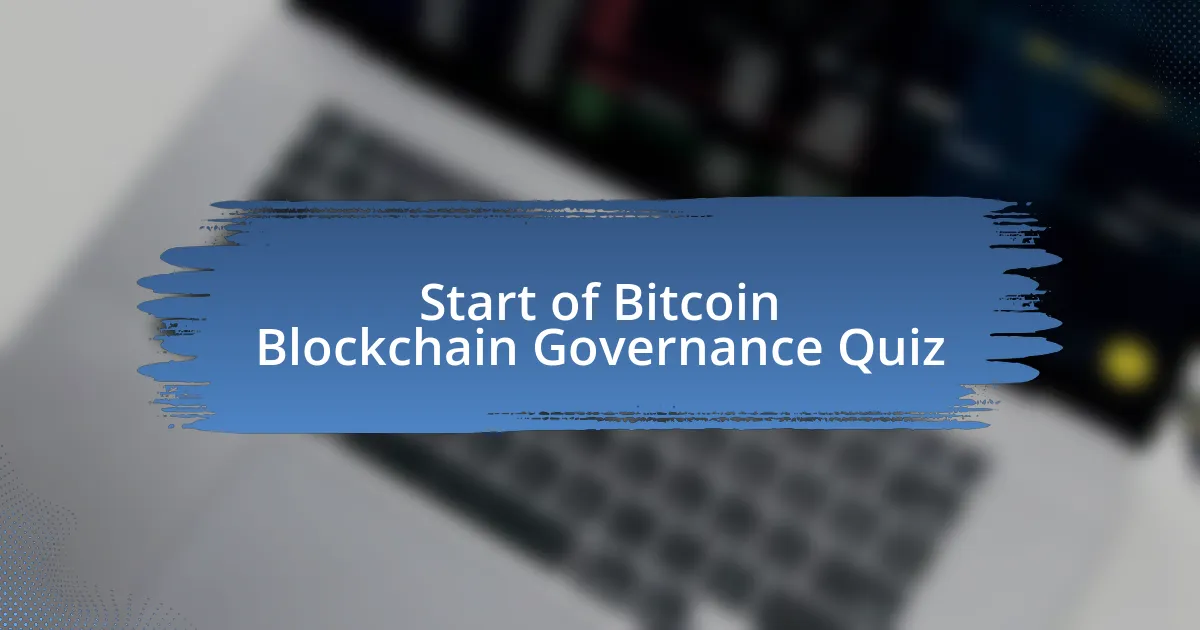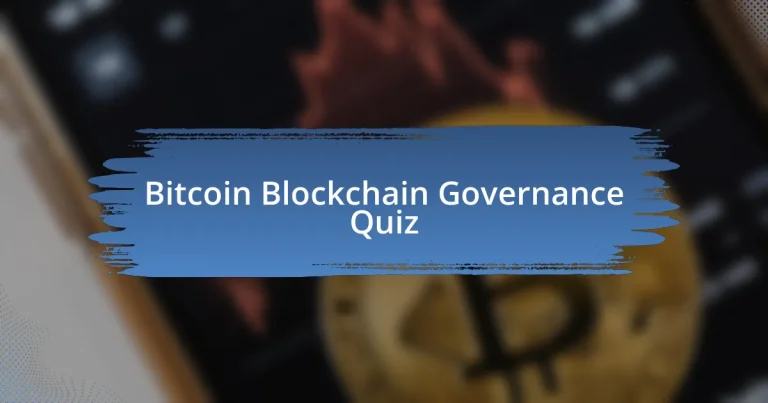
Start of Bitcoin Blockchain Governance Quiz
1. What type of blockchain does Bitcoin use?
- Private
- Consortium
- Hybrid
- Public
2. Which consensus mechanism is better for the planet?
- Proof-of-stake
- Delegated proof-of-stake
- Byzantine fault tolerance
- Proof-of-work
3. Who is NOT involved in project Partior (Cross-border Payments)?
- DBS Bank
- Standard Chartered
- Citibank
- JPMorgan Chase
4. In project Venus (bond tokenization of EIB), which platform was used?
- Cardano
- None (Not specified)
- Ethereum
- Hyperledger
5. What is the primary purpose of Bitcoin`s governance protocol?
- To prioritize faster transaction speeds over security.
- To centralize control to a single entity for efficiency.
- To limit participation to expert developers only.
- To ensure effective governance through its Proof-of-Work (PoW) consensus mechanism.
6. How does Bitcoin`s Proof-of-Work (PoW) consensus mechanism work?
- Miners stake their existing bitcoins to gain the opportunity to create new ones based on a random selection.
- Miners collaborate to complete transactions and share rewards equally among themselves.
- Bitcoin miners race to solve a cryptographic puzzle, with the winner rewarded with newly mined bitcoins and transaction fees.
- Miners create new bitcoins by simply validating existing transactions without any competition.
7. What are the economic incentives in Bitcoin`s PoW consensus mechanism?
- The rewards come solely from transaction fees collected by miners.
- The cost involved in solving the puzzle ensures honesty, as it is economically unfeasible to cheat the system.
- Participants are paid in fiat currency for their contributions.
- There are no economic incentives; miners work for free.
8. Who can participate in Bitcoin`s governance?
- Only government officials can participate.
- Only investors and traders can participate.
- Anyone can participate regardless of race, gender, or age.
- Only developers and miners can participate.
9. What is the role of miners in Bitcoin`s governance?
- Miners create new cryptocurrencies and distribute them.
- Miners are responsible for enforcing laws and regulations in the network.
- Miners participate in solving the cryptographic puzzle to validate transactions and secure the network.
- Miners solely manage Bitcoin`s financial assets and investments.
10. How does Bitcoin maintain network integrity and harmony?
- By allowing unlimited access to all personal data of users.
- Through the collective efforts of various stakeholders and mechanisms for conflict resolution.
- Through decentralized authority granted to one leader.
- By centralizing control in a single governing body.
11. What is the significance of decentralization in Bitcoin`s governance?
- Decentralization centralizes authority, making governance more efficient.
- Decentralization ensures that control is broken up among network participants, making it more resilient and resistant to censorship.
- Decentralization limits participation to only a few trusted individuals.
- Decentralization eliminates the need for miners to validate transactions.
12. What are the three pillars of blockchain technology?
- Decentralization, transparency, and immutability.
- Transparency, flexibility, and speed.
- Centralization, anonymity, and speed.
- Security, scalability, and privacy.
13. What does transparency mean in the context of blockchain?
- Transparency means transactions can be altered by anyone.
- All transactions are public and can be read by everyone on the network.
- Transactions are confidential and hidden from the public.
- Only certain transactions are visible to regulators.
14. What does immutability mean in the context of blockchain?
- Transactions require a central authority for validation.
- Transactions cannot be altered or deleted once recorded.
- Transactions can be changed at any time.
- Transactions are only visible to selected users.
15. What are the benefits of blockchain technology?
- Increased data storage, higher user anonymity, more complicated processes, and expanded centralization.
- Better customer service, lower transaction costs, exclusive access, and unlimited scalability.
- Enhanced security, enhanced speed, fraud control & access levels, no hidden fees, better transparency, true traceability, and improved speed and efficiency.
- Reduced network complexity, guaranteed privacy, fast customer referrals, and limited transaction abilities.
16. What is the term used for a blockchain split?
- A block.
- A node.
- A chain.
- A fork.
17. What is a consortium blockchain?
- A blockchain that operates solely for profit without any collaboration.
- A decentralized network where anyone can join without permission.
- A public blockchain where all transactions are anonymous and untraceable.
- A blockchain network that allows participating members to come from within its organization.
18. What is a public blockchain?
- A closed network that only allows authorized participants.
- A blockchain controlled by a single central authority.
- A private network that restricts access to selected users.
- A non-restrictive and permissionless blockchain network where anyone with internet access can participate.
19. What is a hybrid blockchain?
- A blockchain network that combines private and public blockchain capabilities.
- A blockchain that only allows private transactions.
- A blockchain that is controlled by a single entity.
- A blockchain that has no security features.
20. Which central bank has piloted a CBDC for Financial Inclusion?
- Bank of Japan
- European Central Bank
- Bank of England
- Federal Reserve
21. What is the primary advantage of Bitcoin`s governance framework?
- It restricts participation to only developers and miners to maintain security.
- It centralizes authority among a few key players for quicker decisions.
- It focuses on profit maximization through controlled governance.
- It promotes trust, transparency, and growth through community-driven decision-making.
22. How does Bitcoin`s governance framework differ from traditional governance?
- Bitcoin governance is solely based on the decisions of wealthy investors.
- Bitcoin has a centralized authority that enforces decisions and policies.
- Bitcoin uses a community-driven approach, which is more organic and decentralized compared to traditional governance with a clearly defined hierarchy.
- Bitcoin requires formal voting processes similar to corporate governance.
23. What are the challenges in Bitcoin`s governance framework?
- Conflict resolution mechanisms are essential to maintain network integrity and harmony, and decentralization can lead to challenges in decision-making.
- Limited participation prevents diverse opinions from influencing decisions.
- High transaction fees deter participation in the governance process.
- Centralized control makes decision-making more efficient and straightforward.
24. What is the role of stakeholders in Bitcoin`s governance?
- Stakeholders control all aspects of code changes and updates.
- Stakeholders are only responsible for marketing Bitcoin.
- Stakeholders vote on transaction fees for miners exclusively.
- Each stakeholder has their own interests and influences network decision-making.
25. How does Bitcoin ensure honesty in its transactions?
- Through a centralized authority that monitors all transactions for fraud.
- Through the economic incentives provided by the Proof-of-Work consensus mechanism, making it economically unfeasible to cheat the system.
- By relying on government regulations and oversight to maintain integrity.
- By requiring users to pay high fees for any transaction to ensure honesty.
26. What is the significance of the Proof-of-Work consensus mechanism in Bitcoin`s governance?
- It centralizes control of Bitcoin’s primary functions under one authority.
- It simplifies the mining process by removing competitive elements.
- It ensures effective governance by making it impossible to cheat the blockchain system due to the cost involved in doing so.
- It allows users to make anonymous transactions without any oversight.
27. Who invented the Proof-of-Work consensus mechanism?
- Hal Finney
- Satoshi Nakamoto
- Vitalik Buterin
- Charles Hoskinson
28. What is the impact of Bitcoin`s governance on its network?
- It centralizes control under a single authority, making decisions easier.
- It has no significant impact on the network`s functionality or security.
- It restricts participation to only a few elite users, limiting adaptability.
- It makes the network more resilient and adaptable by distributing authority and control among network participants.
29. How does Bitcoin`s governance impact its users?
- It centralizes power among a few key individuals and hinders user participation.
- It allows any government to control network decisions with full authority.
- It creates barriers that prevent users from making significant decisions about the network.
- It promotes trust and transparency by ensuring that decisions about the network and its future do not rely on one person.
30. What are the key components that drive Bitcoin`s governance framework?
- The framework is solely managed by a centralized authority based in one country.
- The governance framework is driven by a combination of processes involving various stakeholders, including miners, developers, users, and node operators.
- It is governed solely by Bitcoin`s price fluctuations and market trends.
- It relies completely on the government regulations to dictate its processes.

Quiz Completed Successfully!
Congratulations on completing the quiz on Bitcoin Blockchain Governance! Your engagement with this material shows a commitment to understanding one of the most revolutionary technologies of our time. Through this quiz, you’ve likely gained insights into how governance structures operate within the Bitcoin network. You may have also learned about the roles that different stakeholders play and the mechanisms that influence decision-making in this decentralized system.
By working through the questions, you have deepened your grasp of key concepts such as consensus mechanisms, the importance of community involvement, and the challenges of governance in a blockchain environment. Each question has been designed to enhance your understanding and encourage critical thinking about how Bitcoin functions as a digital currency and an innovative technology.
We invite you to expand your knowledge even further by exploring the next section on this page dedicated to Bitcoin Blockchain Governance. This section will provide more detailed information, resources, and discussions that can help solidify what you’ve just learned. Dive in and continue your journey into the fascinating world of Bitcoin and its governance!

Bitcoin Blockchain Governance
Understanding Bitcoin Blockchain
The Bitcoin blockchain is a decentralized and distributed ledger that records all transactions across a network of computers. It operates on a peer-to-peer network without a central authority. Each block contains a list of transactions, a timestamp, and a reference to the previous block, forming a secure chain. The integrity of this ledger is maintained through cryptographic hashing and a consensus mechanism known as Proof of Work, ensuring that all participants agree on the current state of the blockchain.
The Role of Governance in Bitcoin
Governance in Bitcoin refers to the methods and processes by which decisions about the network are made and enforced. It encompasses how upgrades, changes, and proposals are discussed, evaluated, and implemented within the community. This decentralized approach allows for a variety of stakeholders, including miners, developers, and users, to participate in decision-making, ensuring that no single party has authoritative control over the network.
Consensus Mechanisms and Their Impact on Governance
Consensus mechanisms are critical to Bitcoin’s governance model as they establish how participants agree on the state of the blockchain. In Bitcoin, the Proof of Work mechanism incentivizes miners to validate transactions and secure the network. Disagreements over proposed changes can lead to forks if consensus is not reached, which illustrates the influence of governance processes on the network’s evolution. The nature of these mechanisms affects how changes are adopted and the overall health of the ecosystem.
Challenges of Decentralized Governance in Bitcoin
Decentralized governance in Bitcoin faces several challenges, including coordination and communication among diverse stakeholders. Different interests can lead to conflicts, slowing down decision-making processes. Additionally, social factors, such as differing technological philosophies and user engagement levels, can complicate consensus. The difficulty in reaching agreement on critical updates or changes can result in stagnation or division within the community.
Recent Developments in Bitcoin Governance
Recent developments in Bitcoin governance include discussions around soft forks and the implementation of proposed changes like Taproot. Taproot, which enhances privacy and smart contract functionality, was a significant step in the governance process. These upgrades reflect ongoing community engagement and the ability to adapt to new technological advancements. They illustrate how the governance model allows for innovation while maintaining the decentralized essence of the network.
What is Bitcoin Blockchain Governance?
Bitcoin Blockchain Governance refers to the processes and mechanisms by which decisions regarding the development and functioning of the Bitcoin network are made. It involves stakeholders like miners, developers, and users who influence the direction of the protocol. The governance is largely informal, guided by consensus and community discussions, as there is no central authority overseeing Bitcoin’s operation. This decentralized model is crucial to maintaining the integrity and security of the network.
How does Bitcoin Blockchain Governance work?
Bitcoin Blockchain Governance operates through a consensus-driven model where changes to the protocol are proposed, debated, and implemented. Developers propose changes via Bitcoin Improvement Proposals (BIPs), which are discussed within the community. Miners and node operators can signal their approval or disagreement through various mechanisms. Only if a significant consensus is reached, typically requiring over 95% approval from miners, does the change go into effect, ensuring that the network evolves in a manner accepted by its users.
Where does Bitcoin Blockchain Governance take place?
Bitcoin Blockchain Governance takes place primarily in online forums, developer mailing lists, and social media platforms where the community connects. Websites like GitHub are used for documenting proposals and development activities. Additionally, debates around governance occur in various public and private spaces, including conferences and meetups, fostering dialogue among stakeholders from around the world.
When do governance decisions occur within Bitcoin Blockchain?
Governance decisions within Bitcoin Blockchain occur continuously, as the network evolves. Significant decisions arise when new proposals are introduced, during network upgrades, or when there is a need to address critical issues like security vulnerabilities or scaling challenges. Typically, such discussions and decisions can take months or even years, as consensus must be reached among diverse stakeholders before implementing any changes.
Who participates in Bitcoin Blockchain Governance?
Participation in Bitcoin Blockchain Governance includes a wide range of stakeholders such as miners, developers, and users. Miners validate transactions and secure the network, while developers propose changes and improvements. Users, who can be wallet holders or participants in the ecosystem, contribute to discussions and influence outcomes through their actions on the network, such as upgrading software and utilizing advancements.


